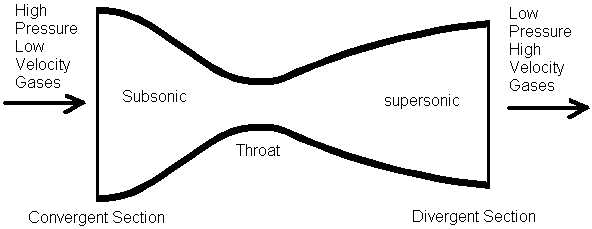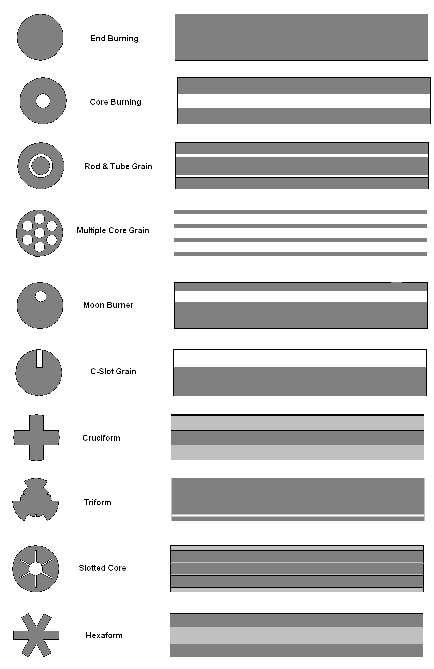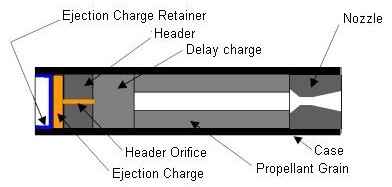|
Home ||
High Power Rocketry ||
Experimental Rocketry
There are basically three types of amateur rocketry today, model rocketry,
high power or large scale rocketry, and experimental rocketry.
Terminology is still not totally consistent and agreed upon by everyone.
Each has its own group of people involved in it and each draws people from a
different interest. Although participants may be involved in more than
one, it is more often that involvement in one leads to another as an
evolution and as a more challenging aspect.
Model rocketry is the most well known and the most commercialized of the
three. Most people have seen Estes model rocket kits and rocket motors
that power them. Estes is the most widely known model rocket company
but there are others and in the past others have come and gone. A person can
build their own rockets from the body tubes, nose cones, engine tubes, etc.
that Estes and others have available but the majority of people build kits.
Most people probably started with model rocketry before moving into the
other two areas and young people involved in rocketry are almost exclusively
involved in model rocketry because of the complexity of the other areas.
Technically, model rocketry is restricted to the following limits:
-
a single motor no larger than 160 Newton-seconds of total impulse (a "G"
Motor)
-
multiple motors no larger than 320 Newton seconds (equivalent to two "G"
motors)
-
motors have no more than 80 Newtons average thrust
-
the rocket with engine weighs no more than 1500 grams
-
the airframe includes no parts of ductile metal.
In addition you must notify the nearest FAA control tower of your activities
when launching model rockets weighing between 454 and 1,500 grams, or whose
total propellant mass is in the range between 113 and 125 grams. This
is so they can route airplanes around your rockets.
Normally, model rocketry is considered to range from
1/4 A to D motors while E through G are often referred to as mid power
rocketry.
Another distinguishing feature of model rocketry is that it generally uses
cardboard, plastic, balsa, and other low weight materials in the rockets for
safety reasons (as well as low cost).
"Large Scale" and "High Power" go together. Larger rockets need larger
engines in order to fly and larger engines will only fit in larger rockets.
High power rocketry starts where model rocketry leaves off. They fly
"H" engines and larger. Commercial engines are available up to "O" in
size. Since each letter doubles the size of the previous letter
designation, an "O" motor is 4096 times larger than a "C" engine that is
most commonly used in model rocketry. The "O" engine price approaches
$1000 and could lift a rocket to five miles.
As engines and rockets get larger, there are more stresses put on the rocket
and so more advanced building techniques and materials must be used.
Recovery systems also get more complex.
Model rocket engines use paper casings, clay nozzles, and black powder for
propellant. Larger engines must use stronger materials for the casing
and nozzles, typically metal, and use higher energy composite propellants.
Large engines are controlled, as is the flying of high power rockets.
Two organizations, NAR (National Association of Rocketry) and Tripoli have
chapters around the United States and abroad, hold launches, and provide
control of the sport through certifications. A person must go through
qualifications including building, preparing, launching smaller rockets and
take a written test to obtain certifications which then entitle them to
purchase engines and fly rockets with those engines. Three levels of
certification are used in both organizations: level 1 is for H and I motors,
level 2 for J, K and L motors, and level 3 is for M, N and O motors.
Experimental Rocketry generally is the term used for rockets whose motors
are homemade and for rockets and motors that do not fall into the other
categories such as those that use metal in the airframes, larger than "O"
engines, etc. Amateur Rocketry and Amateur Experimental
Rocketry (AER) are also sometimes used for this
class of rocketry.
Rocket Motor Basics
You will find many sources that
will refer to rocket "motors" as rocket "engines" and even the venerable
Estes® refers to their motors as engines (the
last time I checked). To be technically correct, nearly all amateur
rockets from the smallest to the largest use motors. According to the
American Heritage Dictionary, a motor is
"something, such as a
machine or an engine, that produces or imparts motion" and an engine is "A
machine that converts energy into mechanical force or motion." A
machine is "A device consisting of fixed and moving parts that modifies
mechanical energy and transmits it in a more useful form." So the
space shuttle engines are indeed engines because they have all kinds of
mechanical moving parts such as pumps and valves. A solid propellant
rocket motor has no mechanical moving parts. The only thing moving is
the igniter as it is ejected out the nozzle and the gas and propellant
particles resulting from combustion of the propellant. There are no
moving parts like there is in your car engine. So unless I slip, I
will refer to all propelling devices in this web site as motors.
An internal combustion engine like your lawnmower, car, truck, small planes,
etc. use a fuel like gasoline or diesel oil. To burn, it must have two
more ingredients, oxygen and heat. The heat is supplied by a sparkplug
or in the case of a diesel engine, the heat comes from compressing the fuel.
The oxygen is taken from the oxygen in the air. In a rocket, the
propellant is a mixture of fuel and an oxidizer and so oxygen is not taken
from the air. That is why a rocket can operate both underwater and in
the vacuum of space. I don't want to get too technical here. I
may add more technical aspects of the chemistry of propellants later or you
can find any number of other web sites that go into great detail. The
oxygen can be pure oxygen such as in the space shuttle that uses liquid
oxygen as the oxidizer and liquid hydrogen as the fuel (this is the most
efficient propellant known), or the oxidizer can have the oxygen as a
component of a chemical compound. There are a great number of
chemicals that are oxidizers. Technically, an oxidizer does not even
have to contain oxygen. It only needs to be the chemical that gives up
electrons in a redox reaction.
The most basic rocket motor consists of only three parts: case, nozzle, and
propellant.

There is one more component actually in the rocket motor and that is the
combustion chamber but in this simplest version, the combustion chamber is
the void area in the center of the propellant. To produce usable
thrust, the pressure inside the motor must be higher than the outside
atmospheric pressure (considerably higher). The higher pressure inside
forces the products of the burning propellant out through a small opening
(the nozzle) at a high velocity. The thrust of the engine is dependant on
how much mass is ejected out the nozzle in a given time and the velocity.
The velocity is dependant on the pressure inside the case and the diameter
of the nozzle throat. How much mass is ejected is dependant on the
burning area and the burn rate of the propellant. The burn rate
depends on the specifics of the propellant such as the chemicals in the mix,
the ratios of the chemicals and the particle sizes used to make the
propellant plus the pressure. The burn rate of rocket propellants
increases as pressure increases. The burning area is controlled by the
shape of the propellant. As you can see, even in the simplest rocket
motor, there are a number of interacting specifics going on that a
rocket motor designer has to keep in mind and figure into the design.
A refinement to the basic motor is the de Laval nozzle. There
are three sections to this nozzle, the convergent section, the throat, and
the divergent section. High pressure, low velocity gas enters the
convergent section and high velocity low pressure gas exits the divergent
section. To be efficient, the gases must be moving below the speed of
sound before entering the nozzle, increase past the speed of sound in the
throat and then the supersonic gas would increase velocity more as it
expanded in the divergent section. If the gas speed were to be
supersonic before reaching the throat, the gas will slow down in the throat.
If the gas is not supersonic exiting the throat, it will slow down in the
divergent section. In an amateur motor, the nozzle can be approximated
with a 45° convergent section and a 15°
divergent section. That is, a side of the nozzle is 45° from the line
running axially through the nozzle, or 90° between the two sides for the
convergent section and similarly for the divergent section, 15° from the
axial line or 30° between the two sides. The angle on the convergent
section has little effect, actually.

One piece of propellant is called a grain. This is left over
from early pyrotechnics where the grain size of black powder was the size of
each piece of powder. So if the propellant is a single solid piece,
then the motor has only one grain. Single use small commercial motors
such as those made by Estes are single grain motors. Most high power
amateur rocket motors have two to five grains in a core burning
configuration (a cylinder with a hole down the center). These are
stacked up one on top of the other. This configuration of two or more
grains is called a "Bates" grain. There are many other configurations
that are used in commercial and military rockets and missiles and a few of
these are being experimented with by amateurs. Below are the end view
of some of
the most common rocket grains. Most of these are the same cross
section for the length of the grains.

Propellant grains are often cast as free standing grains and then inserted
into the motor. These grains can have one or more inhibited
surfaces. Most motors have the outside surface inhibited. This
can be done two ways. The first way is that the grain can have a
coating on the outside so that the propellant surface is not exposed.
This is often just paper of varying thickness that is stuck to the outside
diameter or can be bonded using some type of adhesive. It can also be
a sprayed on coating such as aluminum paint, or can even be tape. It
can be more sophisticated such as a phenolic tube. Another way to
inhibit the outside surface is to case bond the grain to the motor
casing wall. This is usually done when the grain is actually cast
directly into the motor casing. This is another common method for
smaller motors. Conceivably, it could somehow be glued to the wall
when the separately cast grain was inserted but I don't know of anyone that
has done this.
In addition to the outside surface, one or both ends of the grain(s) could
also be inhibited. If no surface is inhibited, then the grain will
burn from the outside in, from the inside out, and from both ends towards
the middle of the grain. The thrust vs. time can in this way be
engineered to a variety of shapes by varying the number of grains, the
surfaces that are inhibited, the core shape, and the diameter and length of
the grains.
In
commercial rocketry, there usually is no recovery mechanism because if it is
a guided missile, the object is to blow up, and in the case of launch
vehicles, the object is to get a payload into orbit and the launch vehicle
is usually only for one use and falls into the ocean. The shuttle
solid boosters are recovered by parachute. These are ejected by gas
producing charges that are triggered electronically. Amateur high
power rocketry has evolved to a similar situation where often electronics
(altimeters and/or timers) triggers a black powder charge that pressurizes
the body tube and separates it from another body tube section or the nose
cone and so parachute(s). In small model rocket motors and the low end
of some high power motors, an ejection charge is built into the motor.


The above diagram is what you would find in a paper casing such as Estes
motors or homemade black powder motors. It is also the same
configuration for PVC motors. In these two cases, the nozzle and
header are normally clay or concrete. The delay charge and propellant
grain would be one solid piece in the case of black powder motors. In
PVC motors, they are usually made separately but are the same propellant
composition. The delay charge can also be a slower burning composition
and could also include ingredients to produce more smoke for tracking
purposes. A portion of the delay charge equal in depth to the wall
thickness of the propellant grain will be consumed at the same time the
grain is burning and will be consumed during the burn. The remaining
amount will burn at near atmospheric pressure and so much slower. When
the Delay charge burns through to the header, it ignites the portion of
ejection charge that is inside the header orifice and communicates the burn
up to the main ejection charge in negligible time. The ejection charge
is usually commercial black powder (4F) and is held loosely (not compacted)
in place by a paper, cardboard, or other relatively fragile retainer cap.
The header orifice must be fairly small so that the majority of the ejection
gases are used to pressurize the body tube and eject the parachute rather
than be ejected back out the nozzle and out of the rocket.
There are other variations in what holds the ejection charges such as
smaller tubes glued either inside the header or outside it but the operation
is still the same. Variations are most common in larger motors where a
smaller diameter delay charge is desired. The delay charge adds a
small amount to the thrust of the motor, especially if it is the same
formula as the propellant grain.
Home ||
High Power Rocketry ||
Experimental Rocketry
|
